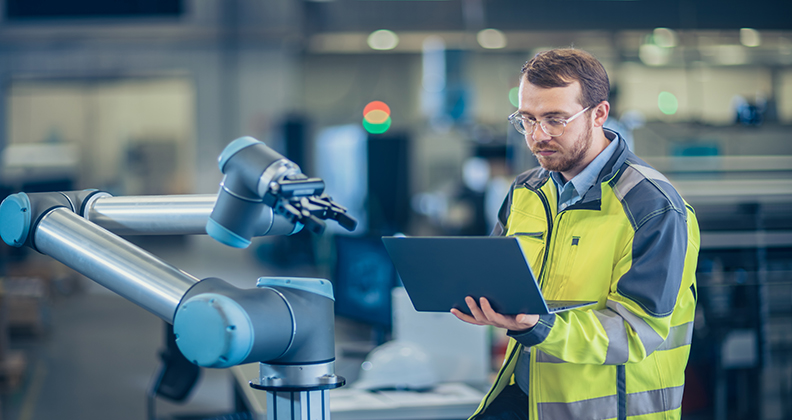
There’s no better feeling for an orthopedic manufacturing manager than to walk onto the shop floor on a Monday morning and see 48 hours worth of implants stacked neatly next to robots that didn’t mind working the weekend. That the product runs were completed while hard-working machinists enjoyed some well-earned R&R makes the feeling that much sweeter.
Good vibes are just one of the benefits of adding automated manufacturing systems to the product production process. Another is a bit more tangible.
“Automation requires a tremendous investment, but the ROI can be realized in months, not years,” said Josh Monesmith, General Manager at Micropulse. He added 20 robots over the last 18 months to the company’s manufacturing floor. “The decision to go all-in on automation has propelled our capacity far beyond what traditional methods could achieve. It aligns with our responsibility to keep pace with our customers’ growing and evolving needs.”
Adding automated manufacturing platforms isn’t as easy as ordering plug-and-play robots. It demands a thoughtful approach, skilled engineers and a team full of nimble professionals who realize robots will allow them to grow professionally in new and exciting ways.
1. Allocation Management
Automation isn’t a universal solution and demands more than a one-size-fits-all approach. “We’ve identified specific areas where manufacturing robots could increase capacity and throughput,” Monesmith said.
Most of the robots that Micropulse added are machine-tending, meaning they replace the need for human operators to perform high-volume, repetitive tasks with short (four- to five-minute) cycle times. Monesmith prioritizes automation for these jobs because of the inherent stability they offer. It also lends itself to a better allocation of personnel. He said that higher volume product runs typically involve implant manufacturing, from interbody spacers for spine surgery to shoulder plates and trauma components.
David Anderson, Co-founder and Business Development Leader at Mach Medical, said the company’s decision to select a fully automated end-of-service clean line was primarily driven by its business model, which is to deliver implants and select instruments in lot sizes as low as one unit and within a three-week lead time. “This allows our customers to reduce inventory requirements by 35% to 85% because we produce only what’s needed when it is needed,” Anderson said.
This nimble business model demands flexibility in terms of the cleaning process steps that are followed for a given part, Anderson noted. “Some parts require citric or nitric acid washes, and some don’t,” he said. “Automation allows us to virtually eliminate the risk of running the wrong recipe for a given part while minimizing the need to batch products through a process that is traditionally batch intensive. We’re able to poka-yoke the selection of the cleaning recipe and optimize the flow-through of the product.”
Anderson said automating the clean line reduces the number of staff members who monitor the process. “We scan parts into the system and load the appropriate cleaning program,” he said. “The equipment runs the product through the correct sequence of stations for the specified amount of time and uses the correct detergent and acid concentrations.”
The automated clean line system also allows for robust real-time data capture, according to Anderson. “It records the time, temperature and concentrations of cleaning cycles to demonstrate that products were run within validated parameters,” he explained. “This information is added to a part’s Device History Record.”
2. Feats of Engineering
Micropulse fosters a competitive spirit among its automation engineering team to optimize processes and maximize output, Monesmith said. “This collaborative approach involves a group of highly skilled individuals rather than a single automation engineer working in isolation,” he added. “We throw ideas at the wall as a group to see what sticks.”
Programming machine-tending robots to maintain quality and maximize productivity requires high levels of creative engineering. Micropulse’s skilled engineers program robots to continue operating during off hours when personnel aren’t available to troubleshoot issues. “That’s a serious engineering conquest,” Monesmith said. “Our engineers have allowed us to capitalize on dark hours that would have otherwise remained unproductive.”
Micropulse’s team of engineers pushes past the limits of what’s currently possible and strives for process improvement. “They’re constantly challenged to maximize the capabilities of our robotic systems and find ways that extract more efficiency and output,” Monesmith said. “In some cases, the manufacturers of our robots are surprised at what we’re able to accomplish with their technology.”
Working with a team of automation engineers is a must for contract manufacturers that often pivot in response to swings in product forecasting or requests for new parts from their OEM partners. Recent M&A activity has gobbled up a few of Micropulse’s smaller customers, some of which increased their product forecasting by as much as 40% under the larger umbrella of their new company.
“We can respond by increasing our production capacity by only so much,” Monesmith said. “Automation allows us to keep up with growing demand when we can’t fill enough off-shifts with manual machine operators. That’s where the true value of the technology comes into play.”
Many of Micropulse’s customers are in a growth state. When an OEM bumps up its manufacturing needs by 1,000 units a month, Micropulse re-engineers the capacity of its current automation systems instead of investing in additional solutions.
“As a contract manufacturer, we make products as long as we’re receiving orders from our OEM customers,” Monesmith said. “When orders change, we need to reset machines and re-engineer the machine-tending robots to make new parts.”
On the other hand, growth-minded companies must actively seek new opportunities for implementing robotics and automation.
“We constantly challenge the industry assumptions of what’s possible,” Monesmith said. “Our engineers are excited by the prospect of tackling challenges and proving that automation can be implemented in ways that other companies might not think is possible, such as for complex finishing automation.”


Micropulse added manufacturing robots to keep pace with the increase in forecasting demands of their customer base.
3. Outside Experts
Mach Medical has realized significant benefits by working with Siemens to automate its engineering transfer process, which typically involves manually building out the required elements of the Device Master Record and process development for each component in a part family. The automated system allows Mach Medical’s engineers to complete the manual tasks for a single component and input the information into the system, which automatically populates it for other parts of the family.
“The overall impact is a reduction in work hours,” Anderson said. “It’s now routinely completed in three months or less, which ultimately translates into faster time to market for our OEM partners.”
Mach Medical learned several invaluable lessons while working with Siemens. “It was an iterative process,” Anderson said. “Bridging the gap between the areas of expertise that both companies brought to the table requires more energy than we anticipated.”
Collaborating with an outside company works well for automating new systems, according to Anderson. “You can engage with the development team early in the process and work through ambiguities or errors in the specifications,” he said.
Legacy products can be a different story. “The history of manufacturing results makes addressing ambiguities tougher because the part-to-part consistency in a family is often lacking,” Anderson said. “In some cases, we don’t see as much benefit in automating the engineering transfer process.”
Mach Medical’s engineering transfer process now takes about three months to complete and uses fewer engineering resources. “In one case, we were able to complete the transfer and an alpha-launch product build of a high SKU-count plating system in just four weeks,” Anderson said. “This type of reduction in engineering transfer time allows our OEM customers to reduce time to market for new products or reduce the time it takes to get a second supplier up and running for supply chain resiliency purposes.”
4. Human Input
Monesmith said deciding between adding manufacturing robots and hiring new machine operators isn’t an either/or proposition. “Last year, we invested heavily in automation,” he said. “We also had our biggest year ever in terms of hiring new members of the manufacturing team. Automation and labor are complementary forces.”
Integrating automation did alter the daily responsibilities of Micropulse’s staff members and challenged them to engage their minds in different ways. “It requires individuals to tap into their creative thinking and troubleshooting skills,” Monesmith said. He recently addressed the company’s entire workforce to make sure they understood that his objective is to have “robots do robot things and people do people things.”
“The effectiveness of automated manufacturing relies on human intelligence,” Monesmith noted. “This synergistic approach has significantly enhanced our capabilities and led to accelerated growth beyond what could have been achieved through the conventional means of employing people and machines. Finding operators to stand in front of machines during eight-hour shifts and push start buttons every couple of minutes isn’t easy in today’s staffing environment,” he continued. “It’s also not the best utilization of their abilities as workers.”
Plus, robots don’t require breaks, don’t call in sick and don’t take vacations. They provide consistent, uninterrupted, round-the-clock productivity. This optimizes door-close time, which is crucial for meeting the demands of high-volume product runs.
“The quicker a machine’s doors close between cycles, the more productive the machine becomes,” Monesmith said. “We’ve observed a significant exponential increase in cycle hours throughout the week after adding the machine-tending robots.”
Investing in automation has also created new opportunities for members of Micropulse’s manufacturing team to acquire new skills. “Many employees have embraced this change, realizing that they no longer need to be solely responsible for pushing buttons and watching parts get made,” Monesmith said. “Instead, they can transition to monitoring multiple machines simultaneously, conducting quality checks, managing tool changes and troubleshooting problems.”
While human input remains essential to keeping manufacturing robots online, the nature of this involvement has shifted. Instead of assuming supervisory roles that are focused on overseeing machine outputs, team members are now asked to take on more dynamic roles in various aspects of the automated process.
“This shift hasn’t led to a specific change in workforce needs,” Monesmith said. “The individuals responsible for programming, fixturing and other technical aspects still must possess a broader understanding of orthopedic manufacturing.”
Future Potential
Monesmith anticipates increasing investments in machine-tending robots and focusing on the tremendous scaling power of automation to cover additional production steps such as cleaning, passivation and finishing that encompass the entire manufacturing process.
“The goal is to strategically utilize automation to free up human resources for tasks that require unique skills and adaptability,” he said. “We want automation to continue handling repetitive and scalable processes.”
Automated manufacturing platforms also possess a certain “wow factor” for prospective customers. “Bringing customers to our manufacturing facility is the best marketing tool we have,” Monesmith said. “When we showcase our automated processes, they can fully comprehend the scale, scope and expertise involved in our work.
“This is particularly crucial in an environment where capacity and on-time delivery are paramount,” he added. “Visiting our facility and seeing the robots in action assures our customers that we’re at the forefront of the industry’s growth initiative.”
DC
Dan Cook is a senior editor with more than 18 years of experience in medical publishing and an extensive background in covering orthopedics and outpatient surgery. He joined ORTHOWORLD to develop content focused on important industry trends, top thought leaders and innovative technologies.




